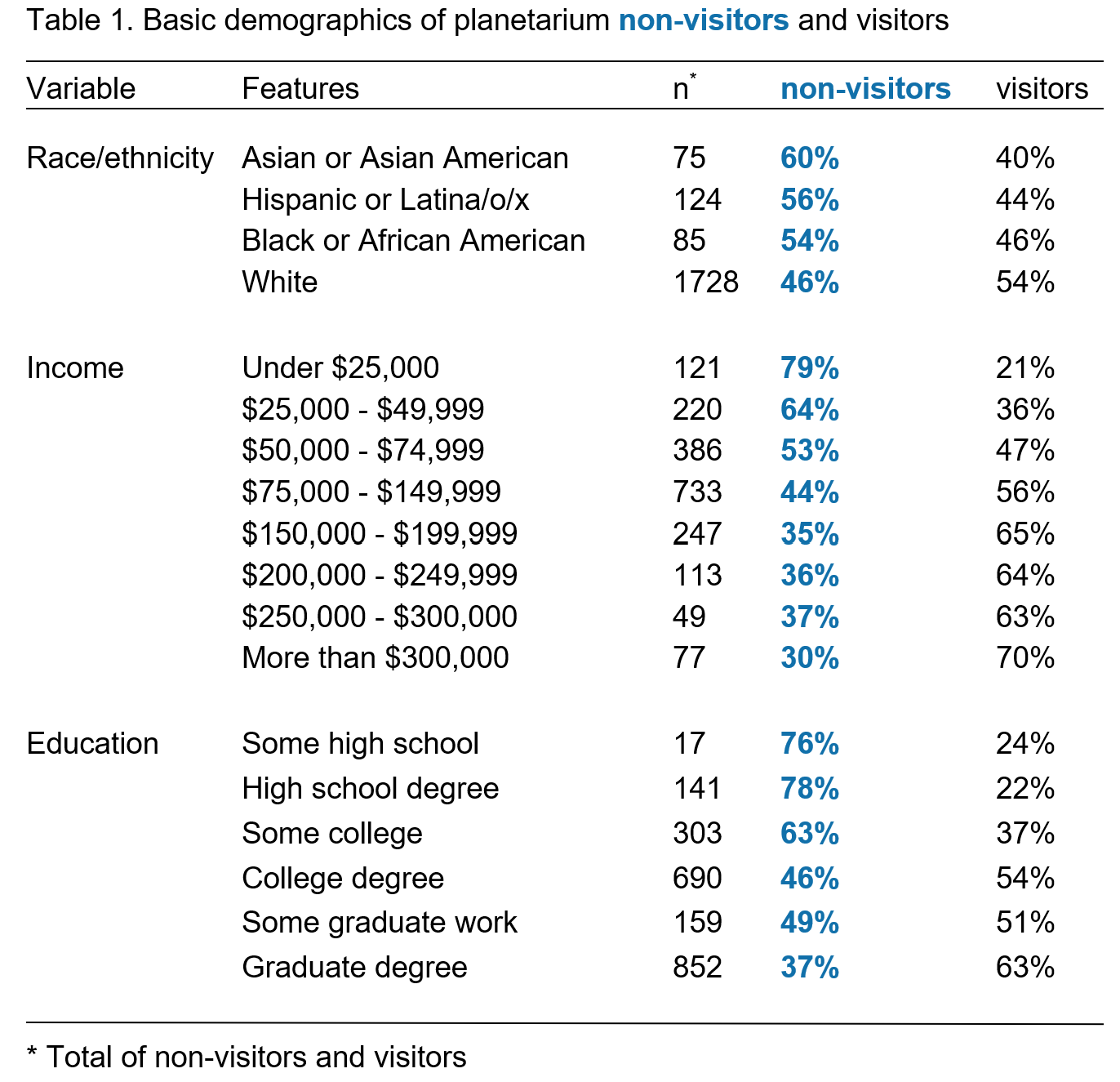Introduction
This blog post demonstrates the value of beginning to study informal science learning (ISL) participants and visitors based on intersectional identities. Intersectionality is the idea that human characteristics such as race and/or ethnicity, gender, socioeconomic status, education, age, etc. are not mutually exclusive within a person, but rather work in concert with (and sometimes against) one another and should be treated as such (Crenshaw, 2017). To date, we are aware of only one study in the ISL field that has studied visitors using intersectional groups (Dawson, et. al., 2020). Our study explored planetarium visitors and non-visitors through both traditional descriptive analysis and a descriptive analysis of intersectional groups. This blog post provides a summary of this study; for a complete description of the study, see Peterman et al., 2022.
Study development process
This study was conceived in 2018 in response to a claim from Immersive Media Entertainment, Research, Science & Arts (IMERSA) that data describing planetarium visitors did not exist (Sumners, 2016). Our analysis was designed to fill this gap, and answers the following questions:
- What is the demographic makeup of both planetarium visitors and those who do not visit planetariums?
- What additional patterns emerge among planetarium visitors and non-visitors when viewed through the intersectional lens of race and gender?
Study implementation
An online survey was administered to email lists from seven planetariums (one from each regional planetarium organization within the United States). Data were also collected via a market research-style survey for each geographic area. The online survey captured planetarium attendance and related behaviors to understand more about the characteristics of those who visit planetariums and those who do not. Survey items were modeled from existing, similar efforts that were designed to gather data from across multiple ISIs via the COVES survey (http://www.understandingvisitors.org/about/resources).
A total of 16,419 participants successfully received an invitation to complete the survey. 1,811 complete surveys were collected, for a response rate of 11%. A total of 672 complete market research responses were submitted through SurveyMonkey Audience.
Project findings
Just over half (52%) of all respondents visited their local planetarium in either 2019 or 2020, and thus were considered visitors for the purpose of this analysis. Men and women were equally likely to be visitors (and non-visitors); 52% of those in each group indicated they had visited a planetarium.
Table 1 presents the portion of non-visitors as opposed to visitors for the remaining items measured, and by the specific features for each demographic item.
- Asian, Hispanic, and Black respondents were slightly more likely to be non-visitors, with just over half reporting they had not visited a planetarium (54% – 60% across these groups). White respondents were slightly more likely to be visitors, with just over half reporting that they had visited a planetarium.
- Over half of the respondents in each of the three lowest income categories reported that they had not visited a planetarium, while more than half of those who reported an annual income of $75K or higher were visitors.
- Over half of the respondents in the lower education level categories reported that they had not visited a planetarium, while more than half of those who reported having a college degree or higher were visitors.
Interestingly, both visitors and non-visitors reported being interested in science. The average interest of non-visitors was 7.41 on an 11-point scale (n=1,049; SD=2.31), while the average interest of visitors was statistically significantly higher at 8.25 (n=1,154; SD=1.68), t(1900) = 9.67, p < .0001. This finding suggests that non-visitors are probably not staying away from planetariums due to a lack of interest in the content on offer.

Table 2 shows the portion of visitors and non-visitors from intersectional groups by combining gender and race/ethnicity. This more nuanced view of the data reveals additional variability that allows us to consider who is missing among planetarium visitors.

The combination of results in Tables 2 and 3 provides additional insight for planetariums to consider. For example, Black males are more likely to be non-visitors than visitors based on the results in Table 3, and the results in Table 4 show a striking difference of more than three points on the scale in the science interest ratings across Black male visitors and non-visitors. Black male visitors reported the second highest science interest rating of any intersectional group, and Black male non-visitors reported the lowest science interest of any intersectional group. A similar pattern was found for Hispanic females and for Black females, though the differences were not quite as pronounced in these cases as they were for Black males.

Insights and next steps
The results shared here are meant to serve as a demonstration of the additional nuance that can be gleaned about visitors if the field begins to conduct intersectional descriptive analyses or formal studies. We believe our findings hint at the value of conducting intersectional studies of ISI visitors in the future, and for planetarium visitors in particular, as a way to help narrow the focus on community members who are not visiting the planetarium. ISI leaders should consider our results in relation to their local context, and as a springboard for additional work. At a minimum, ISIs should invest in regular demographic data collection of visitors using a consistent set of items across programs, events, and members. The field should also consider investing in formal intersectional studies of visitors and non-visitors.
Garibay and Teasdale (2019) recommend strengthening informal science education by privileging the voices of those from communities who are not from dominant groups, and by collaborating with those community members to identify project outcomes. This goal might be achieved by hosting listening sessions with community members from non-dominant groups to learn their impressions of the local ISI, or by forming a community advisory group that includes multiple group members from relevant and non-dominant groups who can help inform decision-making at the ISI moving forward.
If the ISI staff does not include those from non-dominant groups, planetarium leaders should consider whether and how it would be more beneficial to work with external partners to begin this work. Hinojosa et al. (2021) suggest the value of working with a trusted liaison who shares cultural identity with focal communities to first develop outreach initiatives that meet audiences where they are.
The COVID-19 pandemic and heightened awareness of systemic racism have necessitated a field-wide reset as we consider whether and how to become antiracist organizations moving forward. As ISIs consider how to define a “new normal,” it is our hope that the gaps identified here are seen as opportunities to begin to develop reciprocal and meaningful relationships with local neighborhoods and community groups to create more inclusive learning environments for the future.
References
Crenshaw, K. W. (2017). On Intersectionality: Essential Writings. The New Press.
Dawson, E., Archer, L., Seakins, A., Godec, S., DeWitt, J., King, H., Mau, A., and Effrosyni, N. (2020). Selfies at the science museum: Exploring girls’ identity performances in a science learning space. Gender and Education, 32(5), 664-681.
Garibay, C., and Teasdale, R. M. (2019). Equity and evaluation in informal STEM education. New Directions for Evaluation, 2019(161), 87–106.
Hinojosa, L., Swisher, E., and Garneau, N. (2021). The organization of informal pathways into STEM: Designing towards equity. International Journal of Science Education, 43(5), 737–759.
Peterman, K., Martin, K., Robertson Evia, J., Brummel, S., Menninger, H.L. (2022). Who are We Missing, and Now What? A Demographic Study of Planetarium Visitors and Next Steps for the Field. Planetarian, 51(3), 10-18
Sumners, C. (2016). Audiences and evaluation strategic plan. Retrieved from https://www.imersa.org/learn/articles/item/audiences-and-evaluation-strategic-plan-2. December.
Want to keep reading? See Peterman et al., 2022 for a complete description of the study.
Get in touch!
Interested in some of the next steps shared here, but not sure where to start? We can help!




